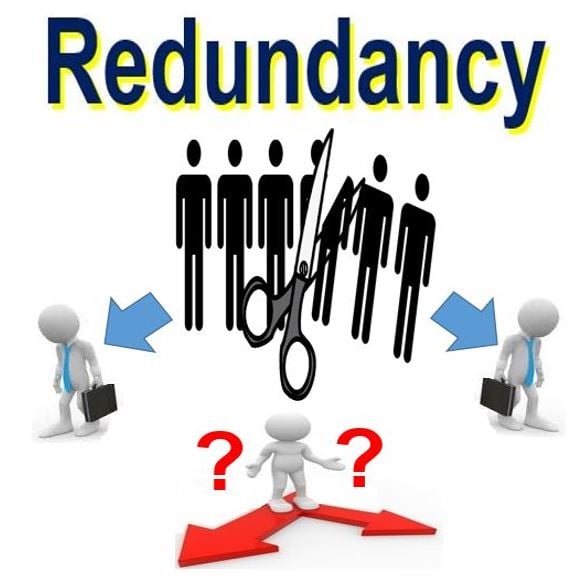What Happens to Redundancy If Company Goes Bust? A Guide to Your Rights
Wiki Article
Checking Out the Interplay In Between Business Redundancy and Business Versatility for Future Growth
In the vibrant landscape of today's company globe, the detailed relationship in between company redundancy and organizational versatility arises as an important aspect for continual growth and success. Firms frequently deal with the obstacle of striking a fragile equilibrium between maintaining a level of redundancy to alleviate threats and cultivating adaptability to respond swiftly to the ever-evolving market needs.Relevance of Company Redundancy
Firm redundancy is an essential aspect that improves business strength and minimizes operational dangers. By including redundancy actions within the business structure, firms can much better hold up against unpredicted disruptions and fluctuations in business environment. Redundancy serves as a strategic buffer, permitting firms to adjust and react successfully to unforeseen difficulties without jeopardizing vital operations.One key facet of the relevance of firm redundancy is its function in guaranteeing continuity throughout times of situation. When encountered with unexpected changes or emergency situations, repetitive systems, resources, or personnel can action in to preserve important functions and prevent prevalent interruptions. This continuity not just safeguards the business's reputation and consumer depend on however also decreases monetary losses and operational downtime.

Strategies for Business Flexibility

One more crucial technique is buying modern technology and framework that can support flexibility and scalability. Executing electronic devices, automation, and information analytics can simplify operations, improve effectiveness, and supply useful understandings for educated decision-making. Moreover, creating adaptable organizational structures that permit quick modifications to market dynamics and client requirements is vital for remaining competitive in a quickly progressing atmosphere. By proactively determining prospective interruptions and chances, organizations can proactively flourish and adapt in an ever-changing business landscape.
Balancing Redundancy and Adaptability
Accomplishing an unified balance between functional redundancy and organizational adaptability is extremely important in navigating the intricacies of a dynamic business setting. you can try these out Striking the right equilibrium between redundancy and flexibility is a fragile process that needs a deep understanding of the company's objectives, industry dynamics, and danger resistance.To accomplish this balance, business require to perform normal analyses of their operations to identify areas where redundancy is required for threat mitigation and where flexibility can drive advancement and growth. Executing versatile frameworks, promoting a society of constant knowing and improvement, and encouraging open communication across all levels of the organization are crucial strategies to balance redundancy and flexibility successfully. By aligning these 2 crucial elements, business can position themselves for lasting development and success in an ever-changing organization landscape.
Study on Adjustment Success
In taking a look at instances of successful business adjustment, it ends up being apparent that the interplay in between operational redundancy and adaptability is a specifying aspect in shaping resilient organizations. One engaging situation study is that of Netflix. Originally a DVD rental service, Netflix demonstrated impressive versatility by transitioning into a streaming system when digitalization interrupted the industry. By purposefully buying modern technology and material creation, Netflix not just flourished yet made it through in a rapidly progressing market. Another standout instance is Amazon. Starting as an on-line bookstore, Amazon continually adapted its organization design, increasing into varied industries such as cloud computer my link and expert system. This flexibility permitted Amazon to stay in advance of rivals and satisfy transforming consumer needs. Last but not least, Adobe offers a significant illustration of successful adjustment. The company moved from marketing software application licenses to a subscription-based version, ensuring persisting earnings streams and improved consumer engagement. These situation researches underscore the importance of functional redundancy paired with organizational versatility in cultivating lasting growth and competitiveness.Structure Strength for Future Development
Building resilience for future development needs a strategic placement of operational procedures with market characteristics and emerging fads. Companies have to adjust to changing settings by fostering a society of versatility, innovation, and continual improvement.In addition, promoting solid connections with stakeholders, such as consumers, workers, distributors, and the neighborhood, is vital for keeping and weathering uncertainties trust fund and support throughout turbulent times. Efficient interaction and transparency play a crucial role in building strength, as they help line up assumptions and help with cooperation in navigating uncertainties.
Moreover, companies need to prioritize understanding and development initiatives to upskill workers and outfit them with the necessary tools to adjust to transforming circumstances. By buying their labor force, firms can boost their adaptability and agility, eventually reinforcing their resilience for sustainable future growth.
Final Thought

In the dynamic landscape of today's organization world, the intricate partnership between firm redundancy and organizational adaptability arises as a vital variable for sustained development and success. Companies usually deal with the challenge of striking a fragile balance in between preserving a degree of redundancy to reduce threats and promoting flexibility to respond promptly to the ever-evolving market needs.To achieve this balance, companies require to conduct normal evaluations of their procedures to determine areas where redundancy is essential for risk reduction and where versatility can drive development and growth.In verdict, the interplay in between business redundancy and business adaptability is crucial for future development. Building durability through a combination of redundancy and adaptability will certainly ensure that business wikipedia reference are prepared for the difficulties of the future.
Report this wiki page